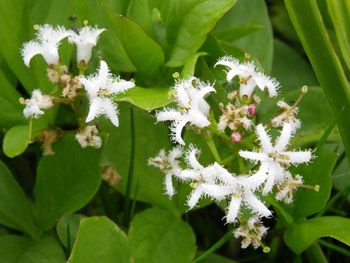Bogbean
Other Names: Buckbean, Buck bean, Herbe à Canards, Marsh Trefoil, Ményanthe, Ményanthe Trèfle d’Eau, Ményanthe Trifolié, Ményanthe à Trois Feuilles, Menyanthes, Menyanthes trifoliata, Trébol de Rio, Trèfle d'Eau, Trèfle d’Eau Commun, Trèfle des Marais, Water Shamrock.
Bogbean is a plant. The bogbean fruit resembles a small bean and is commonly found in swamps or bogs, which is the reason for its name. People use the bogbean leaf to make medicine. Ideally, the leaves of bogbean should be gathered between the period May and July. Soon after collection, the leaves are dried out in the sun or under reasonable heat and stored for use when necessary.
Special Precautions of Bogbean
- Bogbean is safe in food amounts and might be safe for most people when used in medicinal amounts. However, it might be UNSAFE in large quantities. Bogbean can irritate the stomach and intestines and cause diarrhea, pain, nausea, and vomiting.
- Pregnancy and breast-feeding: It might be UNSAFE to take bogbean if you are pregnant. The concern is that bogbean might cause diarrhea. Avoid use.
- Diarrhea, dysentery, and colitis: Avoid using bogbean if you have one of these conditions. It could make your condition worse.
- Bleeding problems: Bogbean can slow down the clotting process. There is a concern that bogbean might make bleeding problems worse.
- Surgery: Bogbean can slow down the clotting process. It might increase the risk of bleeding during and after surgery. Stop using bogbean at least two weeks before a scheduled surgery.
- Medications that slow blood clotting (Anticoagulant / Antiplatelet drugs) interacts with BOGBEAN
Constituents
- coumarins
- flavonol glycosides
- iridoid glycosides (The iridoids are strongly bitter and stimulate digestive secretions.)
- phenolic acids
- pyrrolizidine alkaloids (Very small amounts.)
- sterols
- tannins
- triterpenoids
Health Benefits and uses of Bogbean are
Bogbean contains bitter chemicals that can increase the flow of saliva and stomach juices. This might help stimulate the appetite or relieve indigestion. For therapeutic reasons, bogbean is taken in the form of an infusion or tincture. Infusion: To prepare the infusion, add one to two teaspoonfuls of the dehydrated herb to one cup (250 ml) of boiling water and allow it to permeate for about 10 to 15 minutes. For best results, this infusion needs to be drunk thrice every day. Tincture: The tincture prepared from bogbean should be taken in dosage of 1 ml to 4 ml thrice every day.
- As a bitter agent, the drug promotes the salivary and gastric juice secretion and is therefore used for loss of appetite and indigestion as well as feeling bloated or flatulent. Also in bitter herbal liqueurs and schnapps occasional extracts are included. Fever clover leaves are predominantly used in tea blends. Bogbean is an intensely bitter herb which helps to promote appetite as well as invigorates the secretion of digestive juices. This herb is generally taken to enhance a weak or dysfunctional digestion, especially if the patient also experiences uneasiness in the abdominal region. In addition, bogbean is also used to facilitate weight gain and is considered to be a useful natural medication for treating rheumatoid arthritis, particularly when this malady is related to debility, weight loss and absence of vigour. Generally, herbalists prescribe bogbean in conjugation with other herbs, for instance white willow and celery seed.
- It may be noted that bogbean has intimate relation with gentians that are well-known bitter herbs employed in the form of a digestive as well as a common body tonic. This herb too may be used in the same way, but it may cause irritation to the digestive system, especially if the patient is enduring gastric infection or inflammation. Bogbean possesses astringent, anti-inflammatory, carminative (a medication that eases flatulence), digestive, cathartic, diuretic, deobstruent (a medication that helps to remove obstructions), emetic, febrifuge, emmenagogue (a medication that promotes menstrual discharge), stomachic, hypnotic and tonic attributes.
- Every part of bogbean plant is therapeutically active, but the leaves are used most frequently. It is best to collect the leaves of this aquatic plant in the later part of spring or early part summer and dried out prior to use. Using the fresh leaves may result in vomiting. An infusion prepared with the leaves of bogbean is used to treat muscular debility in M.E., persistent infections accompanied with weakness and fatigue, anorexia (inability to eat), indigestion and rheumatism. When this infusion is given in minor doses of 10 grains it enhances vitality of the stomach and facilitates in digestion. Patients suffering from dysentery, diarrhea or colitis should avoid this herb. In addition, taking the herb in excessive doses may result in vomiting.
- To treat rheumatic conditions, bogbean is combined with celery seed and black cohosh for better results.
- In earlier times, physicians in Europe employed bogbean leaves in the form of a cathartic as well as a medication to cure fevers, constipation, scabies, scurvy, rheumatism and dropsy (formerly known as edema or an anomalous fluid build up inside the body tissues). In addition, bogbean was also reputed for being a useful tonic and for promoting appetite. European settlers who established colonies in America discovered bogbean growing in nature and employed it to the fullest extent like they did in their native lands. A number of native Indian tribes in America boiled the rhizome of bogbean in water to prepare a decoction and used it to cure spitting blood as well as different other internal medical conditions. They also used this aquatic herb to cure jaundice, skin complaints as well as to flush out parasitic intestinal worms.
- The formerly common use against fever can not be reconstructed by the ingredients.
